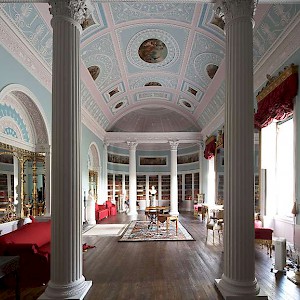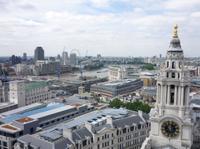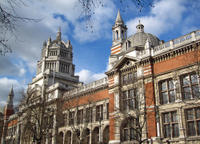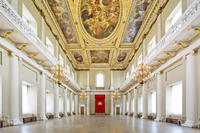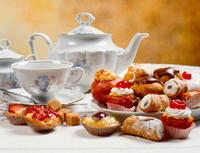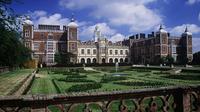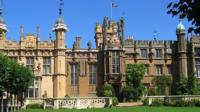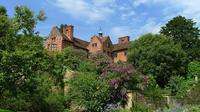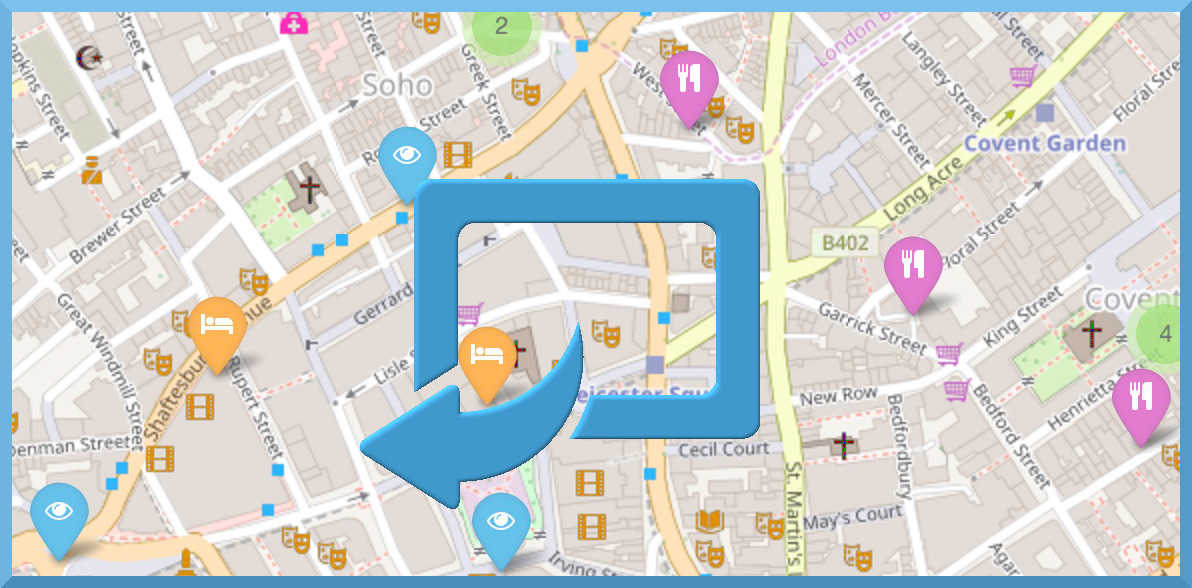Historic Home in London
Sights in London
★☆☆A 17th century manor house in Hampstead Heath with a fabulous free art collection
☆☆☆The house in Hampstead where John Keats wrote his most famous poems and met his love, Fanny Brawne
Historic Home Tours2h | from £300
Have you ever wanted to live like a prince or princess? Our London Tour for Kids in Kensington Palace will take us into the former London residence of Queen Victoria and Princess Diana and current home to the Duke and Duchess of Cambridge. Here we will learn about the rebellious princess who ran from an arranged marriage into the arms of love, and more. These stories are woven into the fabric of the palace through theatrical performances, art installations, fashion, and music, against the backdrop of the historic State Apartments.
- Learn about Royal London in Kensington Palace
- Interactive, learning activities.
- London Tour for Kids led by a family friendly historian.
- Includes skip-the-line tickets.
"Our children are still chattering about the stories of the king who died on the toilet.”
London Tour For Kids - Kensington Palace
Kensington Palace has a rich history that begins with the first monarchs to live there, William III and Mary II, who invaded England and took the throne in 1689 after the Glorious (and allegedly bloodless) Revolution of 1688. Suffering from severe asthma and in need of clean country air rather than the stench and dirt of London proper, William and his wife rebuilt a small country house which became Kensington Palace, home of monarchs.
Setting the Stage
We will hear about their lives, but also of the lives of their often forgotten consorts, Queen Mary the collector, Sophia Dorothea, who never saw England and was imprisoned in a castle for 30 years, and Queen Caroline, an intellectual and one of the most powerful women in British history. After George II, the official residence of the monarch in London moved to Buckingham Palace, though Kensington Palace remained a home for royals. It was here that Princess Victoria spent her childhood and discovered, early one morning in 1837, that the king had died and that she was now Queen Victoria at the age of 18.
Today, the palace is associated with perhaps its most famous residents, Duke and Duchess of Cambridge William and Kate and their children, George and Charlotte.
Looking for more family-friendly activities? Try out Tower of London for Kids or British Museum for Kids Tours.
Take Aways
With the help of our map, the clues, and the palace guardians we will search for these stories and many more. We will enter the world of Kensington Palace and come away having learned about the lives and stories of this magical residence.
FAQ
Who lives in the Palace? Will we see William and Kate?
Current residents include TRH The Duke and Duchess of Cambridge who moved in to Princess Margaret's former apartment with their son Prince George. They have now been joined by Princess Charlotte, born 02 May 2015. Prince Harry also now lives in a separate apartment within Kensington Palace. Their residences are not open to the public, however, we have caught glimpses of the Royal family in the past.
Can I take pictures inside Kensington Palace?
Yes, photography is allowed in Kensington Palace. Please be mindful of both the delicate fabric of the building and of other visitors.
2.5 | from £85
Step in to the decadence and Victorian formality of Leighton House Museum, built in the mid-nineteenth century as the home and studio of artist Lord Frederic Leighton. The newly-restored house and art collection, located in London’s affluent Holland Park neighborhood, showcases not only the objects and spaces that inspired Lord Leighton, but also the beauty of his private world. This Leighton House Tour explores both Leighton's life and the stories behind his beautiful home in the company of a local art historian.
- Small group walks - no more than six people.
- See Leighton’s Arab Hall
- Leighton House tour led by an art historian
Leighton House Tour
In true Victorian style, Leighton was an avid collector of antiquities, and focused much of his attention on the objets d’art that inspired his own creativity and that presented his taste and status to his clients. Leighton trained as a painter in Florence at the Academia di Belle Arti before moving to Paris in 1855, where he rubbed elbows with French Academy painters such as Delacroix and Ingres. By 1860, Leighton returned to London, where he created one of the city’s most remarkable 19th-century estates and a perfect summation of the period’s Orientalist taste.
Leighton's Collection
Leighton brought back the flavor of his travels to his atelier in London, where he incorporated the subtleties of the Orient, the formality of the French, and the opulence of the Italian Renaissance in the adornment of his workspace at his Holland Park home. Accompanied by a local art historian, we'll marvel at the richly decorated interiors of this historic house as we learn more about how Leighton's home reflects the Victorian English society. We'll start in the dining and drawing rooms with an overview of Lord Leighton’s life and career, discussing the relevance of his work to that his contemporaries.
Exotic Tastes
We will then move through the deep blue Narcissus Hall with its mosaic floors and tiled walls into the Arab Hall, the most decorated part of the home. Here, we will look at the fabulous collection of rare Islamic tiles from Damascus and Syria. The walk will continue to the upper floor with a peek into the double-height Studio and the Silk Room, named for its green silk wall coverings and housing the Mashrabiyah window, a decorative screen that allows for hidden glimpses into the Arab Hall. We will end by seeing Leighton’s austere private bedroom.
Looking to see more of London's opulence? Try our Hampton Court Tour or our London City Tour of Kensington and Knightsbridge.
Take Aways
At the end of the walk, we'll come away having experienced unique example of house museum, and having gained a deep understanding of Leighton's life and influence in London and in Europe.
Read more about the restoration on our post detailing the restoration of the Leighton House Museum.
3h 30m | from £116.97
Delve into London’s royal history on this private 3.5-hour morning or afternoon tour. With your very own personal guide, tour Westminster Abbey, the Royal Church of England and the country’s coronation church since 1066. Admire the early Gothic architecture and learn about the royal events hosted there. Then, stroll up Whitehall, where the British Prime Minister is based, to Banqueting House, the only surviving part of the grand Palace of Whitehall. Wander around the banqueting hall, see the ceiling paintings by Sir Peter Paul Rubens and learn about the British royals.
Choose from a morning or afternoon tour, and then meet your guide — an art history specialist — by Westminster Abbey. Snap photos of Gothic crowd pleaser, perhaps the most beautiful early Gothic building in the country, and hear about the abbey’s long, rich history.
As you step inside with your guide, discover how the abbey, a royal mausoleum for many centuries, has been used to crown all the kings and queens of England, except two, since William I’s coronation in 1066.
Learn about the royal weddings hosted here, including the weddings of Queen Elizabeth II to Prince Philip and Prince William to Kate Middleton, and admire the many artworks and monuments dedicated to soldiers, artists, statesman and writers. You’ll also see the College Garden. At some 1,000 years old, it is thought to be the oldest garden in England.
After touring Westminster Abbey, walk with your guide to Banqueting House, the only remaining part of the Palace of Whitehall, a vast royal complex that was burnt down in 1698. Before heading inside, stand on the spot where Charles I was beheaded in 1649 after being convicted of high treason. Then enter the 17th-century building with your guide.
Learn about Charles I and his father, James I Stuart, for who the Banqueting House was built, as you wander from room to room. See the impressive banqueting hall, which would have been used for balls, masques and other royal ceremonies, and admire the elaborate ceiling frescoes that were painted by Sir Peter Paul Rubens.
When the time comes, bid farewell to your guide outside Banqueting House and continue your sightseeing independently or make your own way back to your hotel.
Please note: The Banqueting House is closed in the afternoon. Should you opt for an afternoon tour, you will instead enjoy an extended visit to Westminster Abbey.
1 day 11h | from £89.98
Your tour begins at the Victoria and Albert Museum, London's Victorian center of art and crafts dedicated to the royal couple. Now a museum of arts from all countries, styles and periods. Apart from the main collection of oil paintings and watercolours (with emphasis on the British ones and a collection of Constable's oil sketches), sculpture and architectural examples, the museum contains the world's finest collection of applied arts such as weapons and armours, bronzes and carpets etc. Visit the famous Cartoons for tapestries which Raphael created for Pope Leo X and the recently refurbished Renaissance and Medieval Galleries
Walking along Knightsbridge, London's famous shopping center where Harrods is located, you will reach No.1 London, the name given to Apsley house. Built by Adams in 1775 for Baron Apsley and acquired by the Duke of Wellington in 1817, he aggrandized the house with the help of architect Wyatt who gave it the Corinthian temple front and faced it in gold bath stone. It became the grand mansion of the Duke of Wellington, the victor of Napoleon. You will find the treasures regaled to the Duke by the European Monarchs returned to their thrones after the defeat of Napoleon. As you enter the house in the inner hall is the nude marble statue by Canova of Napoleon in the guise of Apollo. See silver and porcelain sets, jewels and snuff boxes surrounded by the Duke's furniture. Upstairs are the paintings which he collected and the old masters from the Royal Spanish collection found in Giuseppe Bonaparte's coach as he was abandoning Madrid. These were given to Wellington by the King of Spain. Among them are paintings by Velazquez, Rubens, Murillo, Ribera and Goya.(On Mondays and Tuesdays when Apsley House is closed more time will be spent in the V&A Museum.)
This private tour is hosted by a professional guide specializing in art history. Please list any special interests you have (art, architecture, history) at time of booking to alert our guide so that he or she can better prepare for your private tour.
Please note: Apsley House will be closed until March 31, 2015, more time will be spent at the Victoria and Albert Museum.
Varies | from £6.00
Explore London’s royal history with entrance to the 17th-century Banqueting House, the only part of the grand Palace of Whitehall to survive a devastating fire in 1698. See the spot where Charles I was executed after the English Civil War and admire the magnificent ceiling painting by Sir Peter Paul Rubens. Learn about the British royals and discover the story behind this fascinating Italianate building. Upgrade to include admission to London’s other royal palaces: the Tower of London, Hampton Court Palace and Kensington Palace.Make you own way to the Banqueting House, located near the Thames River and 10 Downing Street, where the British prime minister lives and works. This 17th-century building is the only remaining part of the Palace of Whitehall, a vast royal complex that was burnt to the ground in 1698.
Before you enter, pause outside the front of the building on the pavement. This is the spot where Charles I was beheaded on a brutally cold day in 1649, after being convicted of high treason. Head inside to learn more about Charles I and to explore the interior. Architect Inigo Jones designed the Italianate Renaissance-style building and took inspiration for the design from a recent trip to Italy, .
Wander through the impressive banqueting hall, which would have been used as a venue for entertainment. Look out for a bronze bust of James I, which sits above the door in the banqueting hall. The bust was designed by Hubert Le Sueur, who also made the equestrian statue of Charles I in Charing Cross, near Trafalgar Square.
Take some time to soak up Rubens' impressive canvases — exuberant masterpieces that adorn the ceiling of Banqueting House. Commissioned by Charles I, the paintings glorify his father, King James I.
Spend as long as you want in the palace. Once you leave, make your own way back to your accommodation or continue sightseeing.
Varies | from £47.81
Combine old-school English glamor with delicious cakes, sandwiches and tea on this must-do afternoon tea experience in London! Choose between one of two different types of afternoon tea – one with Champagne or one with just tea – both taking place at London’s 5-star Grosvenor House Hotel.
Afternoon tea in London is an institution, owing its origins to Anna, the 7th Duchess of Bedford – one of Queen Victoria’s ladies-in-waiting. As an elite member of Victorian society, she was accustomed to eating large breakfasts, small lunches and large dinners -- the latter served very late each night. To satisfy her afternoon hunger pangs, she summoned her servants to bring tea and cakes.
So delightful was the experience that it became a daily meal and the trend caught on – all over London.
Still going strong today, afternoon teas are served all over the capital, with the most prestigious ones taking place in top hotels -- like the 5-star Grosvenor House Hotel where your afternoon tea experience takes place. Simply choose from one of the following options and relax in an atmosphere of genteel refinement:
Traditional Afternoon Tea:
Enjoy a traditional light afternoon tea, served in style in the Grosvenor House’s library. Taking place between 3pm and 6pm, the light feast includes a pot of classic English tea, traditional (crust-removed) sandwiches, pastries, and scones with clotted cream and fruit preserves.
Anna’s Champagne Afternoon Tea:
Sit down in Grosvenor House’s Park Room, which overlooks Hyde Park, and relax to elegant music from the resident pianist. Created as a testament to Duchess Anna’s legacy, this luxury afternoon tea comprises dainty finger sandwiches, buttermilk scones, cream puffs and pastries -- all served with your choice of fine English tea and a glass of all-important Champagne.
6h | from £225.00
Enjoy a private half-day guided tour of the Hatfield House, home of Queen Elizabeth I. Travel by private car through the beautiful English countryside. Explore the estate's beautiful gardens, and visit the authentic and very historic country home.Take a trip through the beautiful English countryside and visit the gorgeous Hatfield House estate, home of the legendary Queen Elizabeth I, just a short drive north of London in Hertfordshire County.
After being collected from your accommodation in London or at a convenient meeting point in the city, you will take a short but scenic drive to Hatfield House. Stroll through its formal period gardens, featured in many famous films through the years, take a walk through the vast acres of woods and landscaped gardens, or visit one of the several exhibitions at the estate.
If you'd like a whole day out, consider adding the nearby Knebworth House to see a totally different style of country house.
(no rating)6h | from £180.00
Enjoy a private guided 2- to 3-hour tour (excluding travel time) of Knebworth House, home of the aristocratic Lytton Family. Marvel at the beautiful gardens of the estate, and allow the wonderful decor and treasures of Knebworth to take your breath away. Knebworth House is a country house quite unlike any other.After meeting at your hotel or at a convenient meeting point in north London, travel by private car through the beautiful English countryside to the stately home of Knebworth House, where the aristocratic Lytton family lived for centuries.
One of the most recognizable stately homes in Britain, Knebworth House lies in the beautiful Hertfordshire countryside just outside London. Its foreboding exterior has made it a popular setting for films like Batman but it is the beautiful interiors and vast gardens that make this a must-see.
Savor the peaceful estate and its many treasures and works of art as you explore the grounds, and once the tour is complete, travel back to your starting point in London in a private car.
(no rating)6h | from £200.00
Enjoy a visit to the home of legendary Prime Minister, Sir Winston Churchill. With a private guide/driver and in a comfortable Audi car, you will be whisked away from busy London with a short drive through the beautiful English countryside to Chartwell House in the county of Kent. See how Churchill left them and marvel at the gorgeous views that made him pick Chartwell as his family home and also some of the incredible paintings created by the great man himself.
Rarely can any man have been so talented, he being also a distinguished writer and notable historian as well as former soldier. No visitor to Great Britain should miss the home of perhaps one of the most famous leaders in world history as well as his glorious landscaped gardens.With a hotel pickup around 9am depending on your location, this private tour sets off in a comfortable new Audi vehicle. Your guide and driver for the day oversees every aspect of all tours personally so you can be assured for a flexible and friendly professional service.
We will arrive at Chartwell around 10.30am after which we can explore some of the wonderful gardens of Chartwell House, some of which designed and created by Sir Winston Churchill himself. Around 11.30am you will get to go inside Chartwell House, exploring the rooms and seeing the house as it was when the Churchill family lived here. During the visit there is the opportunity to see treasures and memorabilia from around the world that were gifted to the leader of the free-world.
Chartwell House as a lovely cafe/restaurant which isn't included in the price but the chance to experience a cream tea and scone shouldn't be overlooked or perhaps a visit to Churchills Art Studio with dozens of his paintings on display is better if you're watching your figure. Churchill would no doubt have a few words to say on that subject! Finally the drive back to the starting point and you should be back around 3-3.30pm.
These might include historic home
More tours
Historic home links
- Landmarktrust.org.uk - This organization helps oversee and preserve over 190 historic buildings—from castles to mansions to cottages—across Britain. Since there are few enough Lords of the Manor these days to pay for their upkeep and keep them lived-in (old homes deteriorate rapidly when vacant), the Landmark Trust has hit upon the perfect solution: preserve the buildings (and help fund the organization!) by renting them out.
Related pages
Sights in London
A 17th century manor house in Hampstead Heath with a fabulous free art collection
The house in Hampstead where John Keats wrote his most famous poems and met his love, Fanny Brawne
Have you ever wanted to live like a prince or princess? Our London Tour for Kids in Kensington Palace will take us into the former London residence of Queen Victoria and Princess Diana and current home to the Duke and Duchess of Cambridge. Here we will learn about the rebellious princess who ran from an arranged marriage into the arms of love, and more. These stories are woven into the fabric of the palace through theatrical performances, art installations, fashion, and music, against the backdrop of the historic State Apartments.
- Learn about Royal London in Kensington Palace
- Interactive, learning activities.
- London Tour for Kids led by a family friendly historian.
- Includes skip-the-line tickets.
"Our children are still chattering about the stories of the king who died on the toilet.”
London Tour For Kids - Kensington Palace
Kensington Palace has a rich history that begins with the first monarchs to live there, William III and Mary II, who invaded England and took the throne in 1689 after the Glorious (and allegedly bloodless) Revolution of 1688. Suffering from severe asthma and in need of clean country air rather than the stench and dirt of London proper, William and his wife rebuilt a small country house which became Kensington Palace, home of monarchs.
Setting the Stage
We will hear about their lives, but also of the lives of their often forgotten consorts, Queen Mary the collector, Sophia Dorothea, who never saw England and was imprisoned in a castle for 30 years, and Queen Caroline, an intellectual and one of the most powerful women in British history. After George II, the official residence of the monarch in London moved to Buckingham Palace, though Kensington Palace remained a home for royals. It was here that Princess Victoria spent her childhood and discovered, early one morning in 1837, that the king had died and that she was now Queen Victoria at the age of 18.
Today, the palace is associated with perhaps its most famous residents, Duke and Duchess of Cambridge William and Kate and their children, George and Charlotte.
Looking for more family-friendly activities? Try out Tower of London for Kids or British Museum for Kids Tours.
Take Aways
With the help of our map, the clues, and the palace guardians we will search for these stories and many more. We will enter the world of Kensington Palace and come away having learned about the lives and stories of this magical residence.
FAQ
Who lives in the Palace? Will we see William and Kate?
Current residents include TRH The Duke and Duchess of Cambridge who moved in to Princess Margaret's former apartment with their son Prince George. They have now been joined by Princess Charlotte, born 02 May 2015. Prince Harry also now lives in a separate apartment within Kensington Palace. Their residences are not open to the public, however, we have caught glimpses of the Royal family in the past.
Can I take pictures inside Kensington Palace?
Yes, photography is allowed in Kensington Palace. Please be mindful of both the delicate fabric of the building and of other visitors.
Step in to the decadence and Victorian formality of Leighton House Museum, built in the mid-nineteenth century as the home and studio of artist Lord Frederic Leighton. The newly-restored house and art collection, located in London’s affluent Holland Park neighborhood, showcases not only the objects and spaces that inspired Lord Leighton, but also the beauty of his private world. This Leighton House Tour explores both Leighton's life and the stories behind his beautiful home in the company of a local art historian.
- Small group walks - no more than six people.
- See Leighton’s Arab Hall
- Leighton House tour led by an art historian
Leighton House Tour
In true Victorian style, Leighton was an avid collector of antiquities, and focused much of his attention on the objets d’art that inspired his own creativity and that presented his taste and status to his clients. Leighton trained as a painter in Florence at the Academia di Belle Arti before moving to Paris in 1855, where he rubbed elbows with French Academy painters such as Delacroix and Ingres. By 1860, Leighton returned to London, where he created one of the city’s most remarkable 19th-century estates and a perfect summation of the period’s Orientalist taste.
Leighton's Collection
Leighton brought back the flavor of his travels to his atelier in London, where he incorporated the subtleties of the Orient, the formality of the French, and the opulence of the Italian Renaissance in the adornment of his workspace at his Holland Park home. Accompanied by a local art historian, we'll marvel at the richly decorated interiors of this historic house as we learn more about how Leighton's home reflects the Victorian English society. We'll start in the dining and drawing rooms with an overview of Lord Leighton’s life and career, discussing the relevance of his work to that his contemporaries.
Exotic Tastes
We will then move through the deep blue Narcissus Hall with its mosaic floors and tiled walls into the Arab Hall, the most decorated part of the home. Here, we will look at the fabulous collection of rare Islamic tiles from Damascus and Syria. The walk will continue to the upper floor with a peek into the double-height Studio and the Silk Room, named for its green silk wall coverings and housing the Mashrabiyah window, a decorative screen that allows for hidden glimpses into the Arab Hall. We will end by seeing Leighton’s austere private bedroom.
Looking to see more of London's opulence? Try our Hampton Court Tour or our London City Tour of Kensington and Knightsbridge.
Take Aways
At the end of the walk, we'll come away having experienced unique example of house museum, and having gained a deep understanding of Leighton's life and influence in London and in Europe.
Read more about the restoration on our post detailing the restoration of the Leighton House Museum.
Walking along Knightsbridge, London's famous shopping center where Harrods is located, you will reach No.1 London, the name given to Apsley house. Built by Adams in 1775 for Baron Apsley and acquired by the Duke of Wellington in 1817, he aggrandized the house with the help of architect Wyatt who gave it the Corinthian temple front and faced it in gold bath stone. It became the grand mansion of the Duke of Wellington, the victor of Napoleon. You will find the treasures regaled to the Duke by the European Monarchs returned to their thrones after the defeat of Napoleon. As you enter the house in the inner hall is the nude marble statue by Canova of Napoleon in the guise of Apollo. See silver and porcelain sets, jewels and snuff boxes surrounded by the Duke's furniture. Upstairs are the paintings which he collected and the old masters from the Royal Spanish collection found in Giuseppe Bonaparte's coach as he was abandoning Madrid. These were given to Wellington by the King of Spain. Among them are paintings by Velazquez, Rubens, Murillo, Ribera and Goya.(On Mondays and Tuesdays when Apsley House is closed more time will be spent in the V&A Museum.)
This private tour is hosted by a professional guide specializing in art history. Please list any special interests you have (art, architecture, history) at time of booking to alert our guide so that he or she can better prepare for your private tour.
Please note: Apsley House will be closed until March 31, 2015, more time will be spent at the Victoria and Albert Museum.
Make you own way to the Banqueting House, located near the Thames River and 10 Downing Street, where the British prime minister lives and works. This 17th-century building is the only remaining part of the Palace of Whitehall, a vast royal complex that was burnt to the ground in 1698.
Before you enter, pause outside the front of the building on the pavement. This is the spot where Charles I was beheaded on a brutally cold day in 1649, after being convicted of high treason. Head inside to learn more about Charles I and to explore the interior. Architect Inigo Jones designed the Italianate Renaissance-style building and took inspiration for the design from a recent trip to Italy, .
Wander through the impressive banqueting hall, which would have been used as a venue for entertainment. Look out for a bronze bust of James I, which sits above the door in the banqueting hall. The bust was designed by Hubert Le Sueur, who also made the equestrian statue of Charles I in Charing Cross, near Trafalgar Square.
Take some time to soak up Rubens' impressive canvases — exuberant masterpieces that adorn the ceiling of Banqueting House. Commissioned by Charles I, the paintings glorify his father, King James I.
Spend as long as you want in the palace. Once you leave, make your own way back to your accommodation or continue sightseeing.
Afternoon tea in London is an institution, owing its origins to Anna, the 7th Duchess of Bedford – one of Queen Victoria’s ladies-in-waiting. As an elite member of Victorian society, she was accustomed to eating large breakfasts, small lunches and large dinners -- the latter served very late each night. To satisfy her afternoon hunger pangs, she summoned her servants to bring tea and cakes.
So delightful was the experience that it became a daily meal and the trend caught on – all over London.
Still going strong today, afternoon teas are served all over the capital, with the most prestigious ones taking place in top hotels -- like the 5-star Grosvenor House Hotel where your afternoon tea experience takes place. Simply choose from one of the following options and relax in an atmosphere of genteel refinement:
Traditional Afternoon Tea:
Enjoy a traditional light afternoon tea, served in style in the Grosvenor House’s library. Taking place between 3pm and 6pm, the light feast includes a pot of classic English tea, traditional (crust-removed) sandwiches, pastries, and scones with clotted cream and fruit preserves.
Anna’s Champagne Afternoon Tea:
Sit down in Grosvenor House’s Park Room, which overlooks Hyde Park, and relax to elegant music from the resident pianist. Created as a testament to Duchess Anna’s legacy, this luxury afternoon tea comprises dainty finger sandwiches, buttermilk scones, cream puffs and pastries -- all served with your choice of fine English tea and a glass of all-important Champagne.
Take a trip through the beautiful English countryside and visit the gorgeous Hatfield House estate, home of the legendary Queen Elizabeth I, just a short drive north of London in Hertfordshire County.
After being collected from your accommodation in London or at a convenient meeting point in the city, you will take a short but scenic drive to Hatfield House. Stroll through its formal period gardens, featured in many famous films through the years, take a walk through the vast acres of woods and landscaped gardens, or visit one of the several exhibitions at the estate.
If you'd like a whole day out, consider adding the nearby Knebworth House to see a totally different style of country house.
After meeting at your hotel or at a convenient meeting point in north London, travel by private car through the beautiful English countryside to the stately home of Knebworth House, where the aristocratic Lytton family lived for centuries.
One of the most recognizable stately homes in Britain, Knebworth House lies in the beautiful Hertfordshire countryside just outside London. Its foreboding exterior has made it a popular setting for films like Batman but it is the beautiful interiors and vast gardens that make this a must-see.
Savor the peaceful estate and its many treasures and works of art as you explore the grounds, and once the tour is complete, travel back to your starting point in London in a private car.
Rarely can any man have been so talented, he being also a distinguished writer and notable historian as well as former soldier. No visitor to Great Britain should miss the home of perhaps one of the most famous leaders in world history as well as his glorious landscaped gardens.
With a hotel pickup around 9am depending on your location, this private tour sets off in a comfortable new Audi vehicle. Your guide and driver for the day oversees every aspect of all tours personally so you can be assured for a flexible and friendly professional service.
We will arrive at Chartwell around 10.30am after which we can explore some of the wonderful gardens of Chartwell House, some of which designed and created by Sir Winston Churchill himself. Around 11.30am you will get to go inside Chartwell House, exploring the rooms and seeing the house as it was when the Churchill family lived here. During the visit there is the opportunity to see treasures and memorabilia from around the world that were gifted to the leader of the free-world.
Chartwell House as a lovely cafe/restaurant which isn't included in the price but the chance to experience a cream tea and scone shouldn't be overlooked or perhaps a visit to Churchills Art Studio with dozens of his paintings on display is better if you're watching your figure. Churchill would no doubt have a few words to say on that subject! Finally the drive back to the starting point and you should be back around 3-3.30pm.
- Landmarktrust.org.uk - This organization helps oversee and preserve over 190 historic buildings—from castles to mansions to cottages—across Britain. Since there are few enough Lords of the Manor these days to pay for their upkeep and keep them lived-in (old homes deteriorate rapidly when vacant), the Landmark Trust has hit upon the perfect solution: preserve the buildings (and help fund the organization!) by renting them out.

